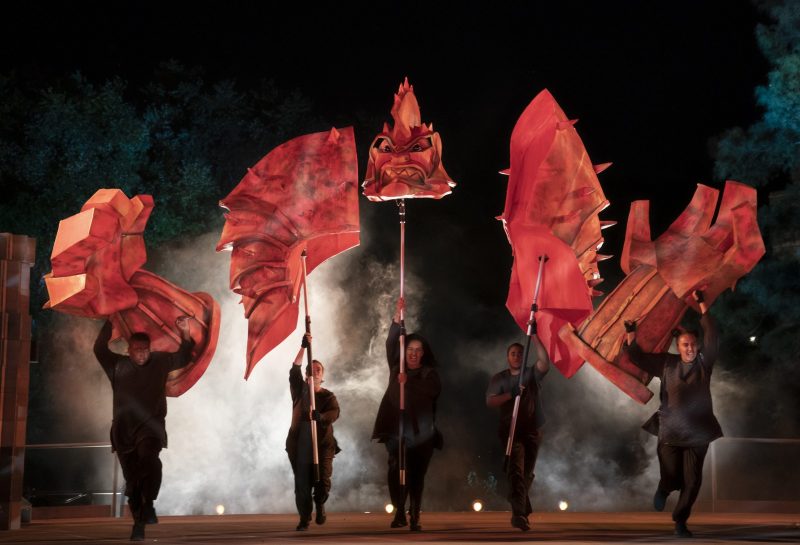In Conversation With...

James Ortiz
Puppet Design, Public Works' HERCULES
James Ortiz is a director, deviser, performer, and puppet designer who’s most known for his Off-Broadway creation, THE WOODSMAN, which earned him a 2016 OBIE award for puppet design as well as a 2019 UNIMA-USA citation for puppetry. Previous credits include: The Public Theatre, Yale Rep, Carnegie Melon University, Dallas Theatre Center, Theatre for a New Audience, Shakespeare Theatre of D.C., Opera Saratoga, Skylight Music Theatre, Soho Rep, Naked Angels, New World Stages, Ars Nova, and 59e59, and others. Awards: 2017 Eugene O’Neill residency recipient, 2015 and 2019 Jim Henson foundation Grant awardee and Co-founder of Strangemen Theatre Company. (www.strangemencompany.com)
Multi-talented artist and puppet designer James Ortiz is no stranger to creating fantastic creatures through puppetry, or transporting family audiences to evocative worlds through theatre.
He dazzled audiences with THE WOODSMAN (created with his ensemble Strangemen Theatre Company), and served as a puppeteer in Blind Summit’s collaboration with Tectonic Theater Project and Gotham Chamber Opera on the epic EL GATO CON BOTAS (Puss in Boots) at The New Victory Theater. This week, he opened one of his most ambitious project yet: conjuring the larger-than-life beasts that attempt to conquer the hero in Disney’s HERCULES.
Coming to life this week through The Public Theater’s groundbreaking annual initiative Public Works, HERCULES arrives on stage at The Delacorte Theater with an impressive cast of professional actors, 200 performers from the community, and an a large ensemble of puppets designed by Ortiz.
As he undertakes this herculean task, Ortiz sat down with TYA Today to share some insight into his process and offer a behind-the-scenes look at this very special Disney screen-to-stage project.
How familiar were you with the HERCULES animated film before working on the project? How much has it directly influenced your designs?
-

I missed the movie when it first came out, so it’s been really great spending time with it for this project. I was very inspired by the film’s warmth and playful sensibility. To me, the whole movie feels like a colorful jazz riff on Greek mythology. So I tried to adopt the boldness and color and freedom of the original animation into the designs. The challenge became, can we go in the fluid jazzy version of what a cyclops is and what a hydra is? There’s a larger-than-life quality that Disney brings anyway, and it has to read as real, but there’s also a warmth, openness, and largeness. It has been a really interesting tone to strike, between the scary and the generosity of spirit that runs through the whole show. I will say that the folks at Disney have been amazing about letting me re-imagine the moments I’m responsible for and not being beholden to any previously made design choices. That’s been very special.
What was your process like in translating characters or sequences into puppetry? What styles of puppetry have you landed on?
-

HERCULES is a story about a hero overcoming unbelievable odds, and a lot of these puppets are used to represent the gargantuan hurdles he has to face in the show. So, the scale of the puppets has to become a big part of the conversation. We can actually create the obstacles that Hercules has to face, and make them real obstacles. Stylistically, it’s all somewhere between oversized bunraku and even larger parade puppets.

Members of the puppet corps of The Public Theater’s free Public Works musical adaptation of Hercules , with music by Alan Menken, lyrics by David Zippel, book by Kristoffer Diaz, choreography by Chase Brock, and directed by Lear deBessonet, running at the Delacorte Theater. Photo credit: Joan Marcus.
"Young audiences are already willing to suspend their disbelief and allow this all to be real, they walk in that way...With a puppet coming on stage, the entire audience can access their childlike self. Making a show that might be a child's first theatrical experience is a real gift to be a part of." — James Ortiz
This project is particularly unique, because you have the opportunity to work with a range of non-professional actors as part of the ensemble that will bring your puppetry to life. What has it been like to design puppetry that will be brought to life by the diverse ensemble of a Public Works production?
-

Puppetry is so exciting for everyone. Whether or not you have a background in theater, you know puppets are strange magic amalgam of your toys coming to life. Everyone is drawn to it. What Public Works manages to do is bring together a community of over 200 people—the most game, warm, thrilled to be there—a lot of people are there because they love the community, or love the chance to try to do this given their jobs and lives have nothing to do this. It’s so lovely. It manifests a generosity of spirit and saying ‘Let’s try it!’ as we’re carrying enormous snake monsters overhead.
I love working with professional puppeteers, but this production is about empowering the Public Works community. I taught non- puppeteers to operate these creations, which I love to do. I led exercises on how to think and breathe together, especially with puppets that require 3-5 performers on some of them. Ultimately, large-scale puppetry is all about teamwork and getting a group of people to work together to create something special. It’s really the best part of the job, so I’m excited about that.
What has been your biggest challenge in adapting HERCULES from the screen to the stage?
-

I think the challenge is making sure that each of these puppet moments are a real challenge for Hercules to overcome. It’s not quite enough for them to be merely spectacle, but we needed to make sure they serve the story of posing a real threat to our hero. Also designing a scary monster that can still fit inside of a warm Disney story has been a really fun line to toe.
This project is one of many that you've created or collaborated on for family audiences. What do you find exciting about creating work for young audiences specifically?
-

I think puppetry is something that will forever be associated with family audiences, and I think that’s fantastic. For me, it’s a funny thing…I think puppetry is the CGI of theatre. It can do anything, it can be anything. The real question for me on any project, is why does this need to be a puppet, and what are you trying to say with this story? I’m not interested in it being purely spectacle, and I’m not interested in it being babysitting. If this can really drive home an idea, of the fact that we are capable of anything, that we are all heroes, then that is what is at the core of what we’re trying to do.
I think many plays have a hard time bearing the weight of including puppets, and material that is inherently magical or about an ensemble coming together tends to work the best inside of the medium of puppetry. Work for young audiences tends to live inside of those themes and therefore we can do some really cool stuff with puppetry therein. Young audiences are already willing to suspend their disbelief and allow this all to be real, they walk in that way. So you can have big conversations through the puppets about the themes, it is more readily available for this audience. With a puppet coming on stage, the entire audience can access their childlike self. Making a show that might be a child’s first theatrical experience is a real gift to be a part of.
PUBLIC WORKS is a national and international initiative of The Public Theater that seeks to engage the people of New York by making them creators and not just spectators. Led by Founder Lear deBessonet and Director of Public Works Laurie Woolery, Public Works deliberately blurs the line between professional artists and community members, creating theater that is not only for the people, but by and of the people as well. Working with community partners in all five boroughs, Public Works invites community members to take classes, attend performances, and join in the creation of ambitious works of participatory theater.

